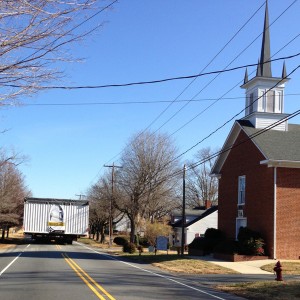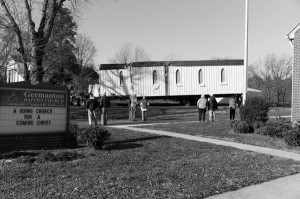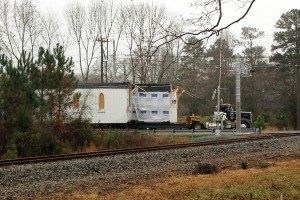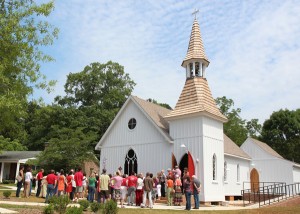In 2012, the Episcopal Church of the Advocate, where I serve as vicar, moved a church. We transported an unused 1891 Carpenter Gothic chapel from its original home in Germanton, North Carolina, to its new home in Chapel Hill.
To move a building a short distance, overhead lines can be taken down temporarily. But for longer distances—such as the 130 miles of North Carolina piedmont our chapel would travel—taking down lines is prohibitively expensive. Instead, the bell tower and roof of the church were removed, in order to keep the clearance under 16 feet. Movers stripped away and discarded old roof shingles. Board by board, they took down the roof, labeling each piece with its original location. Restoration specialists removed the stained glass windows for safekeeping.
The church didn’t just need preservation; it needed restoration, even rebuilding.
As St. Philip’s, Germanton, was taken apart for transport, previously invisible rot and decay revealed itself. The handmade bricks of the foundation pillars had kept the building from resting on the ground for over a century, allowing the air to flow around them and keeping the floor boards dry. But the bricks were too crumbled to be re-used, and were left behind. The window restorers said that the largest windows were so loose in their sashes that the next big wind could have blown them into the worship space. The church didn’t just need preservation; it needed restoration, even rebuilding.
With the use of a large crane, the movers eased the bell tower onto a flatbed. The remaining roofless rectangular structure, 25 feet wide, 90 feet long, and 16 feet high, was wrapped in a kind of shrink-wrap to keep it stabilized. With state-of-the-art jacks and other equipment, it was loaded onto a very large truck for transport. Such an oversized load could not be moved along the highway (Interstate 40), only back roads. Every mile of the route had to be planned and approved by local jurisdictions. Road closures and police escorts had to be arranged. Each town had a different timeframe for such large vehicles to pass by—some specifying early mornings and evenings, others, weekends only. Overhead branches had to be trimmed, and overnight stays planned.
In spite of our celebration, there was tension in the air.
The day of the move, several people from Chapel Hill and several people from Germantown—both opponents and proponents of the move—showed up. In spite of our celebration, there was tension in the air. I invited those who wanted to gather for prayer. Most did; some held back, in too much pain to participate.
I offered a prayer for the people of St. Philip’s Church in Germanton:
“O God,” we prayed, “thank you for the people who founded St. Philip’s, for all of those over the years who worshipped in this chapel—who were baptized, married, or buried here. Thank you for those who so lovingly tended this chapel through the decades. Thank you for others who never entered its doors but were inspired by its steeple as they passed by. O God of our histories, keep their memories alive and your blessings fresh in the coming years.”
We prayed as well for the building on its way to the Advocate in Chapel Hill: “O God, you have never been one to settle down. You are always on the move, calling us to be fellow travelers, ready and willing—like Abraham—to leave home for places we have never been before. O God, bless St. Philip’s chapel on its journey from Germanton that built it, to Chapel Hill that prepares to welcome it. Protect its fabric. Support the drivers who edge its parts down rural roads and village streets. Make skilled workers nimble to put it back together again. Keep blowing through it with the wind of your spirit. No matter who enters, set their hearts on fire.”
The Pastor of Germanton Baptist Church offered prayers as well, and we sang “Amazing Grace.”
The building moved slowly, very slowly, onto the road. The scene caused a certain old-time excitement, like a hot air balloon lifting off or a steam locomotive rolling across the countryside. We all held our breath. The truck and the men who worked to keep the load level and steady moved around the precious cargo, alert to every corner and side, watching monitors and tires and springs.
The church moved through Germanton, diverting traffic and knocking over a road sign on the way. Members of the crew stood on top of the hull, pokers and cutters in hand, making sure the overhead branches were kept away. Others followed behind, sweeping up any twigs, leaves, or branches that fell on the road.
A teenager of the Advocate loaned us her cell phone (an amazing sacrifice) so we could have a GPS signal on the truck to track its location day by day, even hour by hour. It was linked to the Advocate’s webpage. Through a link on the Advocate’s website, folks from Chapel Hill monitored the progress in the weeks that followed. When we could, we drove over from the east to meet up with church on its transport route. We pulled over by a field of sugar cane or tobacco and waited for the entourage. First came the police escorts in cars or on motorcycles, then the church itself. The truck driver honked his horn and waved, and we were filled with a spirit of excitement, movement, and progress. Four days, six days, ten days, a dozen. At night the church slept in the parking lots of wayside general stores or businesses.
The night before the building rolled onto its new location, it rested by the side of the road near Hillsborough, the town just north of Chapel Hill. A group from the Advocate went out to its berth by the highway and prayed evening prayers. As cars blew by, we celebrated “a church on the move,” and realized that we were being formed for our future in ways we did not yet know.
The day of delivery was festive and bright as balloons and streamers waved in the breeze. We were full of excitement for what we had done and for the future ahead. The truck carrying the building pulled in about thirty minute earlier than anticipated. People came running from their cars parked down the traffic-blocked road. Kids took turns ringing the bell that had been removed from the bell tower and temporarily placed on the old well top next to the house. We pulled out the pulpit that was original to the church, and we offered prayers of thanksgiving. Then we had cake.
St. Philip’s Church began its new life as the Advocate Chapel.
But as that first exhilarating hour faded and the day wore on, things were pretty anticlimactic. The specific site on which the building was to be placed needed to be adjusted. Different parts of the frame and braces that had been set up to receive the chapel had to be raised or lowered. And there was a lot of mud. Some waited for the final placement, but many went home. This was the start of what would be another 16 months of adjusting, tweaking, and waiting.
Moving church is slow business. It requires creativity and perseverance, and a lot of communication all along the way.
Photos and videos of the Moving Church can be viewed at http://movingchurch.tumblr.com.
Like this post? Subscribe to have new posts sent to you by email the same day they are posted.







Leave a Reply